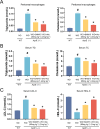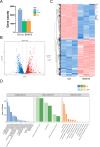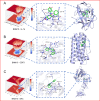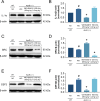Combining RNA-seq, molecular docking and experimental verification to explore the mechanism of BAM15 as a potential drug for atherosclerosis
- PMID: 40247008
- PMCID: PMC12006321
- DOI: 10.1038/s41598-025-98209-3
Combining RNA-seq, molecular docking and experimental verification to explore the mechanism of BAM15 as a potential drug for atherosclerosis
Abstract
BAM15 is a novel mitochondrial uncoupling agent derived from a synthetic source, that has been wildly explored for its ability to enhance mitochondrial respiration and metabolic flexibility. In this study, we investigated the underlying mechanisms of BAM15 on atherosclerosis (AS) through experimental validation, RNA-seq and molecular docking. The results showed that oral administration of BAM15 suppressed atherosclerosis in western diet (WD)-fed ApoE(-/-) mice and significantly improved the hyperlipidemia. And the increased serum ALT, AST and liver TC, TG, ALT, AST in ApoE(-/-) mice were reduced by BAM15 treatment. In in vitro experiments BAM15 inhibited RAW264.7 macrophages invasive ability and reduced palmitic acid-induced lipid accumulation. RNA-seq results confirmed the differential genes after BAM15 treatment and 140 common targets were identified by intersecting with AS-related targets. A protein-protein interaction (PPI) network analysis high-lighted IL1A, SRC and CSF3 as key targets of BAM15 against AS, which is further verified by molecular docking and western blot. Molecular dynamics analysis results confirmed that BAM15 exhibits strong affinity with the IL-1α, SRC and CSF3 proteins. This study indicates that BAM15 inhibits atherosclerosis through a multi-molecular mechanism, and we propose it as a novel anti-atherosclerotic drug.
Keywords: Atherosclerosis; BAM15; Molecular docking; Molecular mechanism; RNA-seq.
© 2025. The Author(s).
Conflict of interest statement
Declarations. Ethics approval and consent to participate: We confirmed that all experiments were performed in accordance with relevant named guidelines and regulations. And the authors complied with the ARRIVE guidelines for animal experiments. The animal study protocol was approved by the Institutional Review Board of Jiangnan University Medical Center (protocol code 2021-Y-51, 31-Aug-2021). Competing interests: The authors declare no competing interests.
Figures













Similar articles
-
Effects and mechanism of Kedaling tablets for atherosclerosis treatment based on network pharmacology, molecular docking and experimental study.J Ethnopharmacol. 2024 Jan 30;319(Pt 1):117108. doi: 10.1016/j.jep.2023.117108. Epub 2023 Aug 30. J Ethnopharmacol. 2024. PMID: 37657772
-
Xinmaikang (XMK) tablets alleviate atherosclerosis by regulating the SREBP2-mediated NLRP3/ASC/Caspase-1 signaling pathway.J Ethnopharmacol. 2024 Jan 30;319(Pt 2):117240. doi: 10.1016/j.jep.2023.117240. Epub 2023 Sep 28. J Ethnopharmacol. 2024. PMID: 37777030
-
Hydroxysafflor yellow A regulates lymphangiogenesis and inflammation via the inhibition of PI3K on regulating AKT/mTOR and NF-κB pathway in macrophages to reduce atherosclerosis in ApoE-/- mice.Phytomedicine. 2023 Apr;112:154684. doi: 10.1016/j.phymed.2023.154684. Epub 2023 Jan 31. Phytomedicine. 2023. PMID: 36738477
-
Hexarelin attenuates atherosclerosis via inhibiting LOX-1-NF-κB signaling pathway-mediated macrophage ox-LDL uptake in ApoE-/- mice.Peptides. 2019 Nov;121:170122. doi: 10.1016/j.peptides.2019.170122. Epub 2019 Aug 3. Peptides. 2019. PMID: 31386895
-
Yang-Xin-Shu-Mai granule alleviates atherosclerosis by regulating macrophage polarization via the TLR9/MyD88/NF-κB signaling pathway.J Ethnopharmacol. 2024 Jan 10;318(Pt A):116868. doi: 10.1016/j.jep.2023.116868. Epub 2023 Jul 16. J Ethnopharmacol. 2024. PMID: 37454749
Cited by
-
Targeting Mitochondrial Dysfunction to Prevent Endothelial Dysfunction and Atherosclerosis in Diabetes: Focus on the Novel Uncoupler BAM15.Int J Mol Sci. 2025 May 11;26(10):4603. doi: 10.3390/ijms26104603. Int J Mol Sci. 2025. PMID: 40429748 Free PMC article. Review.
References
MeSH terms
Substances
Grants and funding
- Y20222018/Science and Technology Development Funds of Wuxi
- Y20222021/Science and Technology Development Funds of Wuxi
- Y20212029/Science and Technology Development Funds of Wuxi
- Y20212005/Science and Technology Development Funds of Wuxi
- Y20212031/Science and Technology Development Funds of Wuxi
- 82300510/National Natural Science Foundation of China
- Q202223/Scientific Research Program of Wuxi Health Commission
- Q202227/Scientific Research Program of Wuxi Health Commission
- Q202329/Scientific Research Program of Wuxi Health Commission
- CXTDPY2021001/Key Subject Medical Innovation Team of Wuxi
- BK20210066/Natural Science Foundation of Jiangsu Province
- HB2023038/Top Talent Support Program for young and middle-aged people of Wuxi Health Committee
LinkOut - more resources
Full Text Sources
Medical
Research Materials
Miscellaneous

